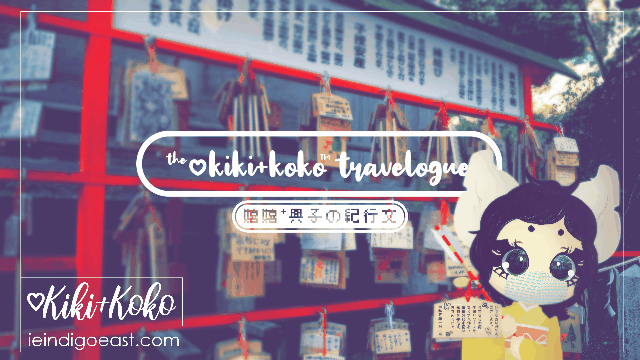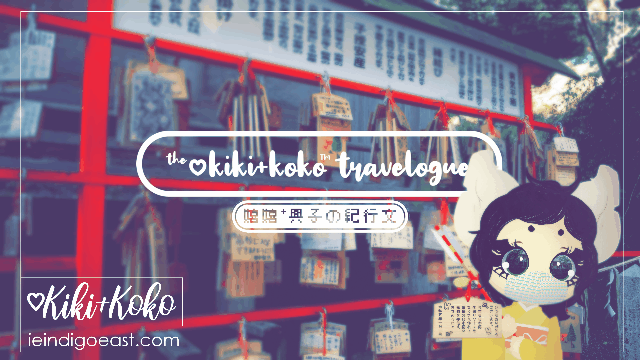皆様、こんにちにゃあぁ!Welcome to Kiki+Koko: Let’s NihonGO!! Online. When you trek off into the forest, hike in the mountains, walk along a stream, or go off of the beaten path, you need more than just your basic camping supplies to sustain yourself. You need to probably know where you’re going with a good ole fashioned guide or you may get in trouble! But, make that double. We’re Kiki and Koko, your cool camp counsellors who let you stay up late as long as you study and finish your vegetables, and your guides when it comes to Japanese language and culture, letting you know what to do in any given situation.
But, even with two, or sometimes three guides, you’ll need a bit more. You’ll need special tools that will give you directions and get you down the path. However! Note that these tools are multipurpose. So, if you see these somewhere else being used for something else, don’t be surprised. A lot of these tools we’re equipping you with are used in several different cases with several different uses, which is, of course, very useful as not to have to carry so much in your backpack of essentials. And, that’s why during these Kiki+Koko: Let’s NihonGO!! Essentials, we try not to load your pack with too much extra baggage to allow you to travel freely and master the initial uses, first, before we give you the basic not-so-much life hacks. No worries, though, we’ll get to the other uses in the next lessons. Particles can fill entire books, so we’re keeping things light.
So, before you jump into this next adventure, you should make sure you have equipped with you your other basic sources of sustenance. And those are:
です、は、が、and を。Have a quick click at these and be sure to return so you can get the direction everyone so desperately needs in their life.
And, by direction, of course, we mean directional particles! Again, these particles have more than just one use, but we’re just covering one use at a time to help you compare, contrast, and grasp these puppies. We’re going to start with one of the seemingly most versatile that you’ll see in so many other cases, but in this case, we’re looking at a particle that covers where things are. And, this is the particle, に, ni. In this case, we’re going to look at に, ni, in two ways: indicating location and direction.
Let’s say that you’re in the middle of a nature hike, your pack on your back, ready to set off on an adventure with your mates, but you’re not actually sure where you’re going.
私たちは 池に 行きます。
watashitachi wa ike ni ikimasu.
We are going to the pond.
In this case, に, ni, indicates that the word before it is the destination.
キャンプ場に 帰りました。
kyanpujou ni kaerimashita,
(We) returned to the campsite.
In this case, it’s usually used when there is motion from one place to another. While normally, you can think of に, ni, as 「to」, there are times that it’s actually 「at.」
VWのワーゲンバスは キャンプ場に 着きました。
VW no waagenbasu wa kyanpujou ni tsukimashita.
The VW bus arrived at the campsite.
But, this is more-so something that happens in translation rather than actually changing the function of に, ni. に, ni, still indicates location in one of the upcoming examples as well, but in this case, it’s about existence rather than the destination. But, before we get to that, there is oddly another particle with the same previous function, however this particle has much fewer functions. For all of your basic essential needs, you can almost entirely whittle it down to just 「to」

You may see へ, he—which is pronounced more like え, e, when used as a particle—in many greetings or simply addresses as 「To:」such as when you’re writing home to your parents to tell them how much Japanese knowledge you’re learning out here and how you might have run out of socks already.
母へ
Haha he
To: Mum
And, you can replace mum with any name and it will have the same 「To:○○」effect by placing 「へ」after it.
○○へ
○○he
To: ○○
But, that’s not the only greeting in which you’ll hear へ, he. If you plan on travelling to Japan, whoever is greeting you upon arrival might say something along the lines of:
日本へ ようこそ!
Nihon he youkoso!
Welcome to Japan!
Oddly enough, though, this is still interchangeable where you could equally replace it with に, ni, but it just doesn’t have the same exact feeling, as に, ni, is perhaps implying entering. So, に, ni, is more ubiquitous in everyday speech, but へ, he, in our opinion, just makes it feel more like its own turn of phrase. So, whilst へ, he, may not be the most multipurpose of them all, there is still another function which they share with に, ni. But, in this case, it’s very directional, also indicating movement, but maybe to differentiate these in your mind, it may feel more like 「towards」 than 「to」, but they’re, even still, very interchangeable in these cases.
来週は、東京へ 行きます。
raishuu wa toukyou he ikimasu
(As for) next week, I’m going to Tokyo.
~
池へ 行きます。
ike he ikimasu.
(We are) going to the pond.
And, there are cases where it simply does not translate in the same way—we will have to go into further detail in the next section.
人熱れが して、テントの 外へ 出られなきゃ。
hitoikire ga shite, tento no soto he derarenakya.
It’s stuffy, I gotta get outside of the tent.
You may have thought it acted as ‘of’, but actually, a different particle is covering this which we will cover soon. (It has a LOT of uses, so be prepared to see that one VERY often). So, even if it’s not evident in the translation, this still indicates direction if you ask the question to yourself to identify it. (This is a very helpful way to identify what the particle is doing as well as the implications)
This is the questioning inside of your head to identify what へ, he, is doing here:
どこへ?
doko he?
Where to?
テントの そとへ 。
Tento no soto he.
Outside of the tent.
Whilst we’ve barely scratched the surface of に, ni, へ, he, is definitely one of the more straightforward ones. We’re going to go into further detail whilst adding another particle to the mix…next time! We wish we could jam pack more into one lesson, but then it becomes a much bulkier and less absorbable lesson. And, we want to make sure that no one is overloaded, yet still gets a great amount of information!
But, if you are in need of learning more, then feel free to give the rest of our lessons a look! On the couple days a week where there isn’t new content, you can take the time to review previous content. It truly helps with memorisation, even a few minutes a day every day to keep these fresh in your mind. And, when you’re out there, you want to have all of the tools we’ve given you on hand!
But, when new information is available to assist you in your Japanese language learning journey, you can’t always be bothered with checking the day of the week. Stay up to date without even having to look at the calendar by subscribing to the Electronic Mailing List of Tomorrow, today, found usually at the bottom of the site page or the sidebar on desktop. You’ll get the latest tools and resources to surviving in Japanese language in straight to your inbox. That’s articles, videos, podcasts, and more. Also, feel free to join our Patreon, if you’d like to support OUR survival and the creation of more content to be made available to as many people as possible.
Thank you for joining us! We hope that you continue with us on this adventure, and we appreciate that you’ve chosen us to assist you on your Japanese learning journey!


































11 replies »